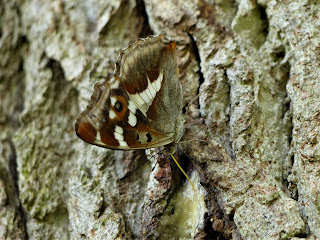Knepp. Neil counted 141 there yesterday, finishing at 7.30pm after a good evening flight, including 18 females - 7 of them involved in tumbledown rejection flights with males, and serial violence against Bullfinch, Great Splatted Woodpecker, Wood Pigeon, Chiffchaff and assorted titmice.
I was there too, but didn't do so well and saw virtually no violence. Males were assiduously searching the sallow fields for females during the morning, which suggests that females are still emerging there. They will stop doing this very soon though, and start taking the mornings off. Be warned. And the males have already stopped descending to feed on the tracks.
Neil and I both walked the Knepp PE transect, 15 mins apart. He and his brother totalled 52 (the third highest count on record, and best after 2018) - but with two counting; I totalled only 43 (one counter) but under-recorded towards the end, as they suddenly conked out in the heat at 3pm.
A lot of feeding on sap runs. Look out for aggregations around veteran oaks, then spot Red Ads and Hornets visiting the small sap bleeds. At one sap run, we had three females perched close by, plus at least two males in the air close by - all had been booted off the sap bleeds by Hornets.
I've no idea what goes on in the mind of the Empress -
Elsewhere, Rev John Woolmer saw only 8 in 4 hours in the main Fermyn Woods block, 9.30-2pm, and met others who had had similar experiences. His conclusion is that the FC's felling of rideside sallows has adversely impacted on the PE, but maybe the season is more advanced there than we think and the males are stopping descending to the rides? However, Fiona Barclay fared much better, counting 12 in 45 mins.
Great that Ian Surnam turned up PE at Coleorton Hall near Ashby de la Zouch in Leics. This is where Coleridge & Wordsworth had their spectacular bust up...
Nationally, the butterfly is now AT PEAK, and seems to be having a very good year nearly everywhere - the exception seems to be the East of England area and much of the region north of the Thames.







.JPG)

















.JPG)











%20-%20Copy.JPG)

%20-%20Copy.JPG)